|
|
|
Sort Order |
|
|
|
Items / Page
|
|
|
|
|
|
|
| Srl | Item |
| 1 |
ID:
155087
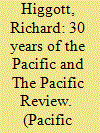

|
|
|
|
|
| Summary/Abstract |
This paper is a review of scholarship found in the pages of The Pacific Review over the last 30 years. It does so in three ways: (1) it highlights issues in the theory and practice of the international relations, strategic studies, political culture and political economy of the Asia Pacific region. (2) It looks at change in the region over time by an analysis of the shifting fortunes of the major regional powers, namely Japan, China and Indonesia and the challenges they, and China in particular, post to US regional hegemony. (3) It looks at regional process reflected in the fate and fortunes of the regional integrative project in the key policy domains of trade, finance and the environment. The paper concludes with a reflection on the strains on the regional political and economic orders by the rise in nationalist politics.
|
|
|
|
|
|
|
|
|
|
|
|
|
|
|
|
| 2 |
ID:
155097
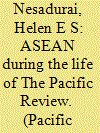

|
|
|
|
|
| Summary/Abstract |
Recent studies of ASEAN have focused on why ASEAN community building has emphasised liberal norms such as human rights, democracy promotion and a commitment to wider participation while maintaining a set of sovereignty-preserving regional principles – the ASEAN Way norms – that have been more suited to securing illiberal agendas and the authoritarian practices of state elites. ASEAN's seeming progressive turn is argued to be instrumentally aimed at buttressing the legitimacy of the grouping as a credible regional institution in international society in which these norms are widely accepted though not uncontested. With recent developments suggesting further consolidation of, or a return to, authoritarian tendencies across the region, state-based modes of governance may become more limited in terms of what ASEAN member states are prepared to endorse. It is, therefore, time for scholars to expand analysis to explore how transnational issues and problems may be functionally governed outside of formal regional institutions involving non-state actors in key roles. While the turn to privately generated standards, rules and practices in global governance is well-recognised and researched, the disparate studies on private governance in South-East Asia are rarely cumulated into a more coherent research programme that addresses the effectiveness of private governance as well as its normative implications. These questions point to a promising agenda for research on regional and other transnational modes of governance in South-East Asia.
|
|
|
|
|
|
|
|
|
|
|
|
|
|
|
|
| 3 |
ID:
155090
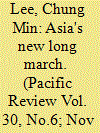

|
|
|
|
|
| Summary/Abstract |
This paper explores the probable causes and consequences of an Asian Paradox or the highly incongruous structure of Asia within the broader international system: at once the engine of global economic growth while at the same time, the repository of all of the world's outstanding security threats and challenges. Asia in the 21st century is going to be a key test bed of the commercial peace theory and whether the U.S.-China strategic rivalry will result in some type of a conflict. Attention is also paid to the potential consequences flowing from the end of Asia's Meiji era or when all of Asia's major powers and key middle powers have achieved or are well on their way of achieving what Japan accomplished by the late 1890s: a wealthy economy and a strong military. How an increasingly wealthy, technologically advanced, and a militarily sophisticated Asia decides to cope with numerous security dilemmas is Asia's new Long March including the extent to which the region's strategically consequential states are willing to preserve and to strengthen the prevailing liberal international order.
|
|
|
|
|
|
|
|
|
|
|
|
|
|
|
|
| 4 |
ID:
155091
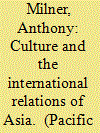

|
|
|
|
|
| Summary/Abstract |
Looking back over the last 30 years, culture as an explanatory factor has been in retreat. Today, however, with the determined reassertion of Islamic values, and an increasingly confident China developing its own international paradigms, the need to investigate cultural and historical specificities is hard to deny. In the Asian region, developments in the South China Sea during 2016 have been especially perplexing for many commentators: International Relations (IR) analysis has come up against a wall of stubborn Chinese and Southeast Asian perspectives. Even some elements in Samuel Huntington ‘civilizations’ approach, widely condemned in the 1990s, today deserve reconsideration – certainly with respect to what Wang Gungwu saw as Huntington's stress on a ‘new language and logic of behaviour’. The common IR analytic framework – highlighting sovereignty, state interests and power (and the balance of power) – needs to be supplemented. Current interest in non-Western IR is promising, especially if it engages in research collaboration with history (particularly the history of ideas, with its focus on close textual analysis). Culture – though certainly in a refined conceptualization – is back.
|
|
|
|
|
|
|
|
|
|
|
|
|
|
|
|
| 5 |
ID:
155098
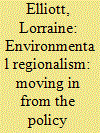

|
|
|
|
|
| Summary/Abstract |
In the last 30 years, environmental challenges in the Asia-Pacific have gone from sitting at the margins of political discourse to featuring prominently in academic and policy debates about institutional capacity, economic sustainability and regional futures. Those challenges are extensive: they include loss of biodiversity and species, land degradation and deforestation, water pollution and scarcity, drought, wildlife smuggling, ozone depletion, other forms of atmospheric pollution, and climate change. This article explores regional responses to environmental challenges through a global governance lens. It examines the ways in which vertical and intergovernmental arrangements have been supplemented by institutions and networks that reflect horizontal and transnational approaches. It reveals that this has been an uneven process, with coherence and fragmentation equally represented. In its focus on the two key subregions of Southeast Asia and Northeast Asia, it shows how environmental cooperation has been implicated in a crisis of regionalism and caught up in states’ efforts to demonstrate that governance can still be effective in the absence of binding multilateral agreements.
|
|
|
|
|
|
|
|
|
|
|
|
|
|
|
|
| 6 |
ID:
155096


|
|
|
|
|
| Summary/Abstract |
Of the recent transformations in the political economy of the Asia-Pacific, one of the most dramatic has been to the region's trade architecture. For many years, Asian government were committed trade multilateralists: pursuing liberalisation either globally through the GATT, or regionally via APEC's model of open regionalism. Underpinned by US and Japanese leadership, this system provided the foundation for the export-driven Asian economic miracle. But since the early twenty-first century, the system has been rapidly transformed. The proliferation of preferential trade agreements has threatened to undermine the cohesiveness of regional trade arrangements. The emergence of WTO-Plus style liberalisation, emphasising services, investment and intellectual property, marks the maturation of a system previously focussed on tariff reduction and manufacturing exports. Since 2011, competition between two ‘mega-regional’ proposals – the Trans-Pacific Partnership and the Regional Comprehensive Economic Partnership – is also indicative of new splits which cut across traditional developmental divides. Growing geopolitical rivalry between the US and China has also raised question of who will lead the next round of liberalisation in the region. Exploring these new trends, this paper argues the trade architecture of the Asia-Pacific is entering is becoming more contested and fragmented, with major implications for economic regionalism in coming years.
|
|
|
|
|
|
|
|
|
|
|
|
|
|
|
|
| 7 |
ID:
155095
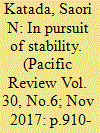

|
|
|
|
|
| Summary/Abstract |
Over the last 30 years, East Asia has progressed from virtually no intergovernmental arrangement in the 1980s to exclusive financial regionalism supported by strong centripetal forces in the aftermath of the Asian Financial Crisis (1997–1998), but this move has not yet produced coherent regional financial architecture. This article examines the evolution of Asia's regional financial architecture of the last three decades and discusses factors that have promoted and inhibited Asia's efforts toward financial regionalism. Since the Global Financial Crisis (2008–2009), the centripetal forces that aided the region's defensive regionalism have weakened, and the crisis has moved the region to seek multiple sources of financial stability from global to regional. On the one hand, given its export-promotion strategy, East Asia still relies heavily on the global financial architecture, and the region's US dollar dependence continues. On the other hand, the Global Financial Crisis has triggered China to seek reform in global financial order and some alternative solutions. For the latter, its monetary authority actively engages in internationalization of its currency, Renminbi, and promotion of the Asian Infrastructure Investment Bank. In this environment, coherent financial regionalism for East Asia is yet to emerge, as East Asian governments continue to search for monetary and financial stability.
|
|
|
|
|
|
|
|
|
|
|
|
|
|
|
|
| 8 |
ID:
155094


|
|
|
|
|
| Summary/Abstract |
Few countries have been burdened with such great expectations as Indonesia and have failed to meet them in the ways expected. Economists have persistently predicted that Indonesia could be an economic giant in the region, challenging the state-led economies of Northeast Asia on the basis of free market policies. After the fall of Soeharto in 1998, pluralist political scientists saw Indonesia as a shining light for democratic transition. More recently, Indonesia has been hailed as a model for how democracy might work in a Muslim-majority country. Yet, we are still waiting for a new economic giant to emerge while democracy has not been able to resolve growing concentration of power and wealth in Indonesian society or to stem growing social resentment. Reactionary Islamic populism has often threatened Indonesia's reputation for religious moderation. Why have so many analysts had such great expectations of Indonesia and how have they explained the seeming disappointments? We propose that the institutions of markets and democracy are not a good starting point for explaining things. The problem lies in the way economic and social power is constructed and in the interests of powerful oligarchies that continue to dominate the political and economic landscape.
|
|
|
|
|
|
|
|
|
|
|
|
|
|
|
|
| 9 |
ID:
155093
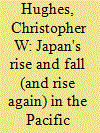

|
|
|
|
|
| Summary/Abstract |
Japan has featured prominently in The Pacific Review (TPR) since the journal's inception; and the very first issue in 1988 was essentially a Japan special issue with four out of six articles devoted to considering the implications of the country's then seemingly relentless rise as a regional and increasingly global power. Thereafter, TPR has carefully documented Japan's changing international pathway, forming indispensable reading for all Japan experts. TPR has always been distinguished by a rare ability to question the conventional wisdom on the study of Japan.
|
|
|
|
|
|
|
|
|
|
|
|
|
|
|
|
| 10 |
ID:
155089
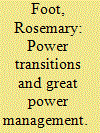

|
|
|
|
|
| Summary/Abstract |
What kind of challenge did a rising Japan in the 1970s and 1980s pose to the United States, and how does that differ from the challenge that China has posed to US primacy in East Asia since the early 2000s? This article compares and contrasts US responses to these two shifts in relative power, in the process aiming to elucidate how changes that portend a power transition are understood and dealt with and how great powers manage the security order at times of disruption. In these respects, the article contributes to the empirical understanding of why some power transitions do not result in conflict given the tools available to great powers to manage relations at times of stress.
|
|
|
|
|
|
|
|
|
|
|
|
|
|
|
|
| 11 |
ID:
155092


|
|
|
|
|
| Summary/Abstract |
When external eyes turned to China 30 years ago (if they did at all), the focus was still on the extent to which it might be breaking away from its socialist economic past. And though we did not know it at the time, intra-elite debates over how far (and to where) reforms should go would eventually play some part in shaping what happened in Tiananmen Square in 1989; events that would place China on the verge of international isolation. This paper traces the evolution from isolation to a position where some in China now think it is now second only to the USA in the ranking of world powers. It will focus on how scholarship on China in the journal has changed over the years, but also on some of the constants and recurring questions and issues that have inspired research over the years. In addition, notwithstanding a very real and very large shift in China's global power capabilities, it will suggest that asking if China matters, or more correctly, how China matters in different issue areas, remains a very useful intellectual exercise today.
|
|
|
|
|
|
|
|
|
|
|
|
|
|
|
|
| 12 |
ID:
155088


|
|
|
|
|
| Summary/Abstract |
The study of international relations in or of Asia is no longer atheoretical, as was the case only three decades ago, when the Pacific Review was founded. But how serious are the efforts to study the international relations of Asia theoretically? Some Western scholars argue that writings on Asian International Relations (IR) are still peripheral to the major concerns and debates among IR theories such as realism, liberalism, and constructivism. The ‘indigenization’ of Asian IR theory remains limited by, among other factors, a tendency among local scholars to rely heavily on Western theories, and the close academia-officialdom nexus in the region that inhibits theoretical work. But this essay argues that Asia offers an opportunity to IR theory for broadening itself and shed its hitherto Westerncentrism, especially at a time of a ‘global’ turn in IR (global IR). Theoretical writings on Asian IR are already making a difference by exposing the limitations of mainstream IR theories in the regional context. And they have the potential to offer new and alternative concepts that are more contextually grounded and relevant for Global IR. At the same time, there remain some important conditions that must be met before theoretical writings on Asian IR can make further progress and realize their full potential.
|
|
|
|
|
|
|
|
|
|
|
|
|
|
|
|
|
|
|
|
|